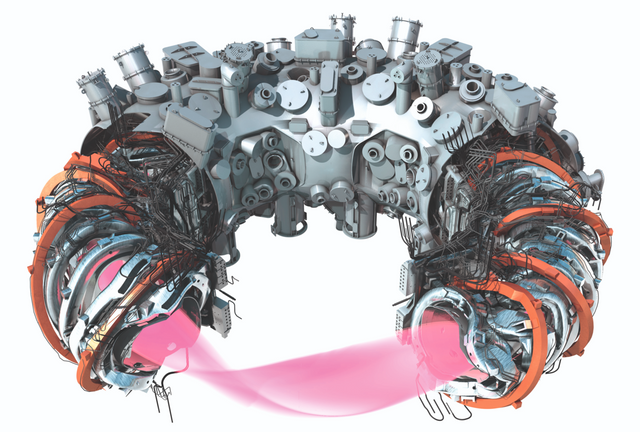
Hello everybody!
More and more news has been coming in over the past year about new records of plasma confinement in tokamaks, but the tokamak is not the only thermonuclear reactor with which one can try to do this.
A stellarator (from Latin stella - a star) is fundamentally different from a tokamak in that the magnetic field for plasma isolation from the inner walls of the toroidal chamber is completely created by external coils, which, among other things, allows it to be used in a continuous mode.

"Regular" stellarator.
Such a magnetic trap for confining high-temperature plasma was invented by physicist L. Spitzer back in 1950, and the first sample, as part of the secret Matterhorn project, was built the following year.
Why few people know about these reactors?
The fact is that, with all the positive aspects, the design of the stellarator is extremely complex, which is why their main problem is high heat losses.

Differences between a tokamak (left) and a "regular" stellarator (right). © Deutsche Physikalische Gesellschaft
This heat loss is the result of a process called neoclassical transport, in which colliding ions in a fusion reactor cause the plasma to diffuse outward. Its effect in stellarators is greater than in tokamaks.
Real progress in the development of these reactors came only at the beginning of the 21st century - with the development of computer systems for engineering design and topological optimization methods using artificial intelligence. But until now there has been no practical implementation of these technologies.

Wendelstein 7-X.
In the newest configuration of the W7-X stellarator, developed in Germany, the magnetic field is created exclusively by one winding (instead of two, as in previous versions), consisting of modular three-dimensional toroidal coils, the complex curved shape of which was calculated using the aforementioned computer systems.
Optimized with the help of a special program, the W7-X stellarator was able to reach temperatures of almost 30 million ° C, which is twice the temperature in the sun's core.

Wendelstein 7-X. Credit: Bernhard Ludewig / Max Planck Institute of Plasma Physics.
Yes, this is just another step towards the implementation of thermonuclear fusion technology, but a rather serious step. Given that various technologies are currently being developed, the implementation of one of them seems only a matter of time.
Well, the W7-X stellarator is currently undergoing modernization and will resume operation in 2022.
For more,you can visit this community
JOIN WITH US ON DISCORD SERVER:
Downvoting a post can decrease pending rewards and make it less visible. Common reasons:
Submit